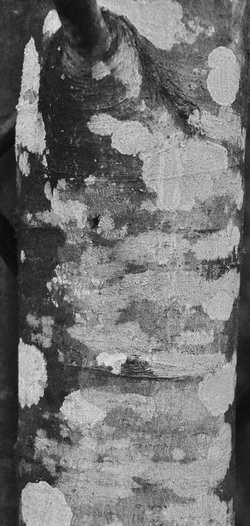 Scouler's Willow (sometimes call the Upland Willow) (Salix scouleriana) is a large shrub to small tree here at Leaning Oaks. Mostly, they go unnoticed except for a few glorious weeks in the fall when their many medium to small leaves turn bright yellow. Our biggest one is behind the deck over the pond and in the fall it reminds me of those fireworks that explode in sprays of yellow. The bark (pictured here) is almost always covered with patches of a light coloured lichen - which we haven't tried to identify yet. Scouler's Willow lives in a variety of habitats and as its alternate common name suggests it thrives in sites that are more upland than many species of willow. It's wood is sometimes used by carvers. It can be a useful species for vegetating an area, and branches, even quite large ones, root readily when stuck into the ground in moist soil.
0 Comments
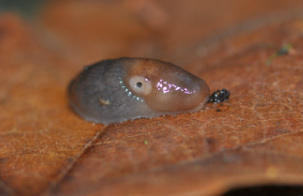 Or Chestnut Slug -or in several places , "no common name". Derocerus invadens went totally unnoticed by us until malacologist Robert Forsyth was visiting, turned over a tile and pointed it out. He also happens to be the person who wrote the Land Snails of BC. He knows his stuff. This species has been tracked on its invasive path from Italy in many parts of the world, seemingly only limited by cold winters. The first record in Canada was 1966 in a greenhouse in Quebec and then the first outside record was at UBC in 1974. Since then it has been found in various locations on southern Vancouver Island (Hutchison et al 2014). That same paper cites a study where this species was unable to survive a temperature colder than -6.4 deg. C. It hit -5 a couple of nights ago and we do get below that a number of times in the winter, so whether the tramp becomes another pest at Leaning Oaks is yet to be determined! 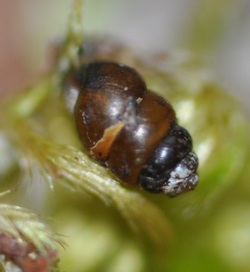 This will be one of the smallest organisms that we tackle on species a day! The lower photo shows one with a fingernail as a size reference. In 2010 the Threaded Vertigo was listed as Special Concern by the Committee on the Status of Endangered Wildlife in Canada, the full report is here. They seem to be found mainly on Bigleaf Maple trees on southern Vancouver Island, the Sunshine Coast and one on Saturna Island and have minimal dispersal capabilities -i.e. they ain't flying or jogging to the next tree, which may be a long ways a way when you are but a couple of millimetres long. 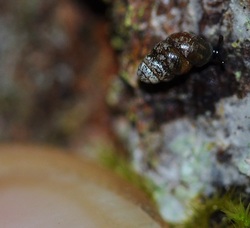 The ones that we have found have all been on two stems of one maple and are either in the cracks or on the moss...interestingly at eye height. I'm sure that isn't sampling bias. At present this species is just known as Nearctula sp. 1 . There isn't any question on the validity of the species, just that it is in a been a taxonomic muddle. Clavulina cristata is a mycorrhizal fungus that grows on the ground and is scattered beneath the Douglas-fir. They start out glowing white and become kind of peachy yellow with age. There are some complications with identification as there is another fungus that will attack this one, changing the colour so that it is similar to a different Clavulina. One author just suggests referring to all white pointy corals as belonging to the "Clavulina cristata group". I'm good with that!
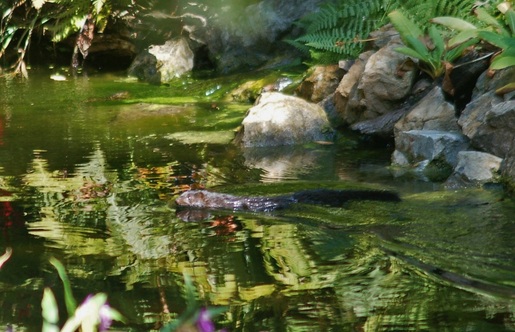 We have recorded two members of the weasel family here at Leaning Oaks, River Otter and Mink. Two others are possible, Pine Marten and Ermine, although to date, we haven't observed these latter two yet. Mink (Neovison vison ) likely are here more often than we know, hiding and hunting under our decks or in among the shrubs, largely out of site. Occasionally we catch a glimpse of one crossing a path or popping up onto on of the decks. Small birds often alert us to their presence, and alarm calls from Dark-eyed Juncos or Spotted Towhees are always worth investigating. Our longest looks tend to come when one visits the pond and hunts for Bullfrogs, such as the one in this photo. Bullfrog hunting by mink is a frenetic affair, with the mink moving rapidly and constantly, entering every small crevice and hollow around the edge of the pond, looking for hiding bullfrogs. 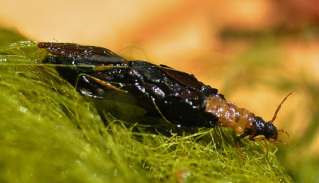 There is that startle factor when a little pile of fir needles or debris marches across the bottom of the pond. All spring and summer the bottom is alive with the larval caddisflies (Limnophilus in this case). The larval cases provide camouflage, shelter and protection for their soft bodies and stability in flowing currents. An excellent overview of this architecture was written by Rob Cannings and in the Royal BC Museum publication "Curious". http://curious.royalbcmuseum.bc.ca/caddisfly-architecture/The story of how the caddisfly got it's name is delightful: Hundreds of years ago in England, itinerant sellers of cloth fastened scrap pieces of cotton and silk to their clothing to advertise their wares. In older English these scraps are called cadices, so these salesmen were dubbed “caddice men”. The little caddisfly larvae that labour away in streams and ponds, covering themselves with bits of sand and plants, probably got their name from these once-familiar figures. (Dr. Rob Cannings) 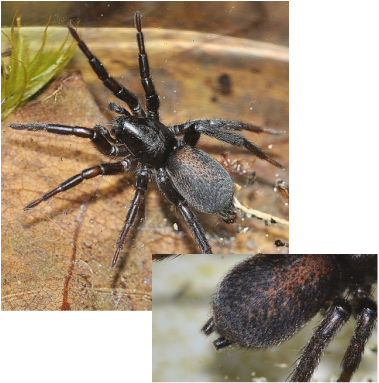 Spinnerets Spinnerets A member of the family Gnaphosidae or "stealthy ground spiders"--not a name that is going to win Zelotes fratis many friends I am afraid! They are not often encountered out in the open as they tend to to be mainly nocturnal, and spend time under logs, rocks or debris. This one was found at the edge of the Douglas-fir forest. They hunt on the ground, not using a web to capture their prey. The spinnerets are cylindrical, a bit like dual exhaust pipes and and often easy to see. Thanks to Claudia and Darren Copley for all of their help in searching for, identifying and wrangling of these guys (and most of the spiders to follow! 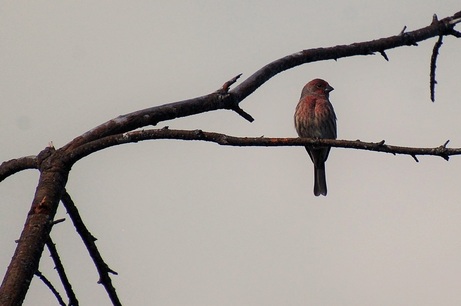 House Finches (Haemorhous mexicanus ) are year-round visitors here at Leaning Oaks, although, to our knowledge, we have not had this species nest on the property. Perhaps our place is too wooded for this species. They are most often seen at the feeder, where they are rather aggressive competitors against other birds. Most males are a raspberry pink colour, but occasionally we have a male that has a yellow pigment in place of the red. House Finches are rather recent immigrants to Vancouver Island, first appearing here in the 1930's. Since then they have spread up the east side of the island and then spottily over much of the rest of the island. They are often confused with Purple Finches, but House Finches have a shorter, rounder bill and heavily streaked sides. Rubbery, gelatinous and with a bit of a glow makes this fungus somewhat surreal growing from downed woody material and decaying stumps in damp areas. The spores are produced from the "teeth" or spines that extent from the lower surface. Pseudohydnum gelatinosum is the only jelly fungus with teeth. Cat's Tongue or Jelly Hedgehog are two other descriptive English names. There are two forms, one with a stalk like this one and without. The stalkless for is more common in the east. Where we are not.
They really are blue!! Or at least this one was. Prophysaon coeruleum comes in a range of blues and greys so I was very pleased that my lifer was not some dull grey.
We have had squares of cardboard out all over the property for the past three years and the checking has been a bit perfunctory unfortunately. Well, maybe not so much perfunctory as without much hope. There has been a lot of peering for a whole lot of snails, isopods or slug frass. Today that all changed! The little endangered slug (SARA listed) is just over a centimetre and a half long and was was snuggled in to the corrugations. This species has been found in locations around Leaning Oaks, but never very often and never in abundance. There seemed to be no reason that it wouldn't be here. The fabulous local organization, Habitat Acquisition Trust or HAT has a program enlisting the help of landowners to put out the cover objects and then monitor them to get a better idea of the Blue-grey Taildropper range. They have also had some great identification brochures made to help differentiate between this critter and some of the other common species in the Victoria area. Information on this program with links to the ID guide are here. There are times where a species may seem at first blush to be rare, but once there is a concerted effort to search, it may not be the case. With this species, the HAT work has shown that they do occur in more areas than previously thought - but that they are not a common slug. Inventory is the best way to assess how at risk a species is. 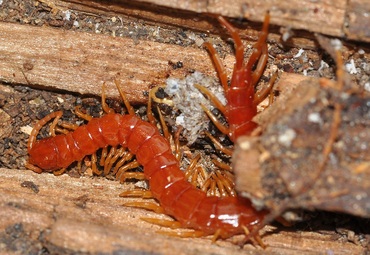 The Order (Scolopendromorpha) that this centipede, Scolopocryptops spinicaudus belongs to contains the largest known centipedes; there is one species within it from Venezuela that grows to 28cm! This was not that large...a mere 6-ish centimeters. The English name refers to the Order, not Leaning Oaks unfortunately. They have formidable forcipules located under their head (left had side of the photo) that they use to capture their prey (smaller arthropods) and inject venom. I couldn't find out if this species can do damage to you or I. Although all centipedes to have a toxic venom, most are unable to penetrate our tough skin. And the toxicity may generally enough to cause swelling and some pain. These guys are built for speed, and if you look at the plates, you see that they alternate between larger and smaller. This helps to reduce the undulations that come naturally from a slender object running forward at great speeds. And because everyone want to know,"What is the difference between a centipede and a millipede?" I have always looked at the number of legs per segment and if it is one, then it is a centipede. There are other characteristics and this chart sums them up. 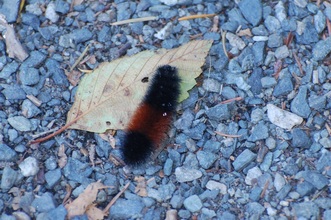 This might be the most recognized moth larvae in North America. Almost everyone recognizes the fuzzy, black-at-both-ends caterpillar that you find on the ground in the fall. It eventually turns into the golden yellow Isabella Tiger Moth. Here are some interesting Banded Wooly Bear (Pyrrharctia isabella) facts: - Sedro-Woolley, a town in Washington State is said to be named after the caterpillar. However since the Phillip A. Wolley, a railroad developer moved the Sedro in 1899 and was a major land developer in the area, that story seems unlikely. -Arctic populations of Wooly Bears can take several years (up to 14!) to grow into moths, and they pass the winters frozen solid. -Folklore has it you can predict the severity of the winter by looking at the bands, the wider the copper band, the milder the winter. In actual fact, there is considerable variation in band width within a group of silbling hatched from the same egg case. -the hairs of Wooly Bear can cause dermatis in some people. -at least 8 towns in eastern North America have Wooly Bear festivals in the fall. I figured after writing out that English name that no further text would be required! It is descriptive. The long neck enables this beetle to reach inside of the shell of a snail and chew away. They also are quite keen on slugs and I have seen them scurrying along the path with a small slug clutched firmly. They will also take out worms and spiders.
Like many of the ground beetles, Scaphinotus angusticollis is flightless, their wings shortened to uselessness. Although mainly nocturnal, a few do venture out in the daytime from their cover places under rotting logs, leaf litter or moss. There was a PhD these done out of UBC by Suzy Lavallee that studied S. augusticollis's response in body condition and movements to forest harvesting. The differences in responses were correlated to the snails found and down woody debris that could be used for cover in the clear-cut or forested areas. I think that is very cool that ecological studies studying predator/prey complexes in varying ecosystems can be done at this scale. 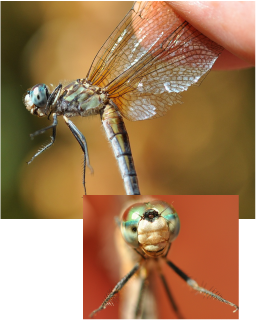 This was a species that I was keen to find. It was fitting that this one was caught at the pond by Syd Cannings one hot, sunny afternoon in August. Syd has been a dragonfly collecting partner for many years and taught me a lot of what I know about them. Thanks Syd! We haven't found exuvia or larva of this species or seen mating so we aren't sure yet whether it is breeding in the pond or passing through. Pachydiplax longipennis are generally found in larger ponds or lakes and are very common in southern North America. In B.C. they are in the southwest corner and the infrequently in the Okanagan. 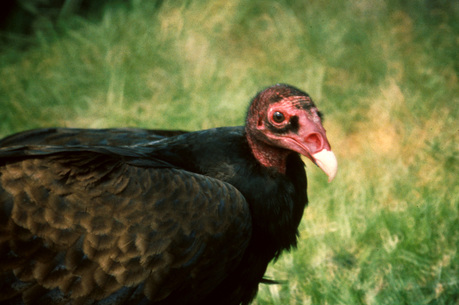 Turkey Vultures (Cathartes aura) are a common sight here during the summer and fall months. Almost always seen flying over Leaning Oaks with wings outstretched and tipped upwards, they have a distinctive rocking back and forth as they fly. They are most noticeable on nice days when they stay aloft on thermal uprisings. They also seem to appreciate the assist of a good wind storm as well, and we see Turkey Vultures using high winds to keep themselves aloft with little or no apparent effort on their part. Here we have Turkey Vulture records from the third week of February to the middle of November. They are clearly increasing in numbers as well as how long they stay, with small numbers being found year round on southern Vancouver Island now. It is suspected they have been assisted with a contant supply of road-killed animals on ever busier road and milder winters.. 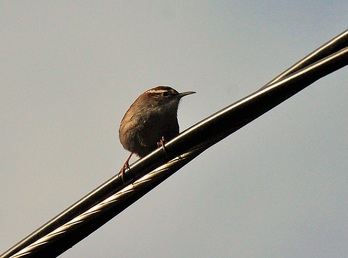 Amongst local birders there is a running joke that if you hear a bird noise that you don't know - it is a Bewick's Wren (Thryomanes bewickii). Males have multiple songs that they can sing (from half a dozen to almost 2 dozen depending on the male), and there is considerable local geographical variation on top of that. Throw in a few chucks, whistles, burrs and trills and you get a lot of variety. Click here to listen to Bewick's Wren vocalizations from througout their range. They often nesting in human made things like mailboxes, shoes, hats, nest boxes and other cavities. Loud and visible, Bewick's Wrens are often hard to ignore neighbours. They are present at Leaning Oaks from time to time and have raised families here, but we also have had them disappear for months at a time some years, particularly after period of cold weather. Of our 3 wrens it is the longest tailed and has a distinctive white eyebrow stripe. I was quite keen on the jaunty art nouveau pattern, found on the orb weaver Metellina segmentata.
The web that this spider spins has no threads at its centre. This is common for the tetragnathid spiders. M. segmentata was introduced to the Vancouver area from Europe and is now one of the more common orb weavers in the Vancouver and Seattle areas. It generally builds it's web low and near the ground. Thanks to the person who provided the correct identification of this species -much appreciated! 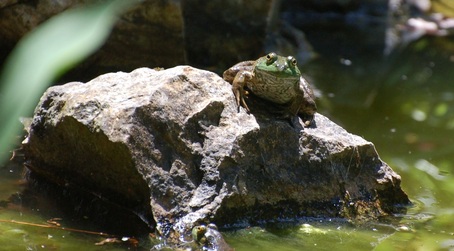 We built a small pond in garden here a number of years ago, and, for the most part it has been an amazing attractant for all manner of critters. We have had River Otters and Mink, Mallards and Kingfishers, at least 8 species of dragonfly, and many other water dependent invertebrates. One of the first vertebrates to find the pond however was this species, Lithobates catesbeianus a very large non-native frog that colonized our new pond the very first rainy night in August. So far despite the size of some of the frogs in the pond we have not had any evidence of breeding. No egg masses, no tadpoles. This is because our pond builds up Bullfrogs in large numbers from immigration, and then becomes a mecca for predators. The first mass control of Bullfrogs took place on two consecutive nights when a mother and four or five River Otter kits visited. They took the frogs down to a small number and the remainder became food for another weasel family representative, a Mink. Then another late summer rain and the pond became colonized by bullfrogs again. This year a young Great Blue Heron has been visiting the pond and targeting the bullfrogs. Our pond is a sink, it doesn't add to the population of Bullfrogs. Its not all rosy though, we suspect the high number of Bullfrogs is the reason why we have not recorded Red-legged Frog on the property. Tree Frogs apparently don't breed in our pond either and we have only ever seen a single salamander larvae. When the numbers of frogs are high, we suspect the numbers of damselflies is lower. We have watched Bullfrogs try to take birds - up to the size of an American Robin! 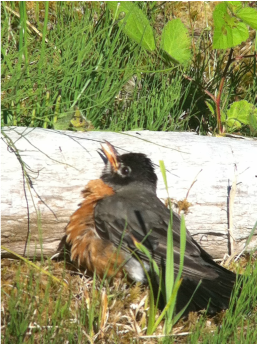 American Robins (Turdus migratorius) are found year round at Leaning Oaks and we have records for every week of the year. In the fall and winter, they are found in gangs, as they forage widely for berries. In late September they flock to the black berries of Phytolacca clavigera in the garden, in October the big draw are the ripening berries of the Arbutus Trees (species #30). They are one of the earliest songbirds to start singing here both in terms of the time of year, as well as being one of the earliest in the morning. Thrushes, as a general rule are active earlier and later in the day than many songbirds. Males are more brightly patterned than females. The male on the right here is sunning himself on a warm evening in the summer. The female (below) is slightly less colourful, but easily recognized as an American Robin.  The Bigleaf Maple is the largest maple in Canada, reaching up to 36 meters in height. The leaves are huge to match, the deeply lobed leaves can be up to 30 cm across and are also the largest in Canada. Possibly the most dangerous as well -last night as I was driving home, one of these behemoths fell and splayed itself across my wind shield. I could see nothing. There are a few very large Acer macrophyllum on Leaning Oaks, putting their roots down in the moister areas. 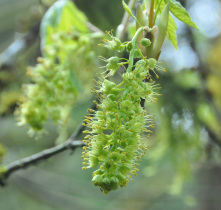 The buds start showing in April, followed by the honey sweet smell of the flowers. These flowers are edible and we'll often put a few in a salad. The other very yummy part is the sap; maple syrup from Bigleaf maples is very different than what comes from the eastern sugar maples. It is much richer and amazingly variable from tree to tree. The jars of syrup below; were all produced by Connie and Ralph Johnson in one year from the Cowichan Valley. The flavour will vary as much as the colour. Ralph is shown working at tapping a Bigleaf maple. The sugar content of the sap is much lower, so the amount of sap required to get a good syrup is greater. The tapping is usually done in January. Maple syrup photos by Connie Johnson. 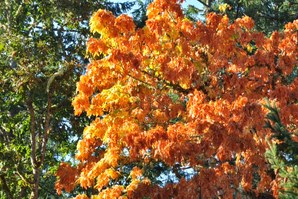 The strong close grained wood was used for paddles and dishes by local First Nations. The inner bark was used for rope and baskets. The bright yellows and oranges in the fall gives what is generally a subtler show of colour here on the coast a bit off oomph. |
AuthorsTwo biologists on a beautiful property armed with cameras, smart phones and a marginal knowledge of websites took up the challenge of documenting one species a day on that property. Join along! Posts and photographs by Leah Ramsay and David Fraser (unless otherwise stated); started January 1, 2014. Categories
All
Archives
May 2025
|
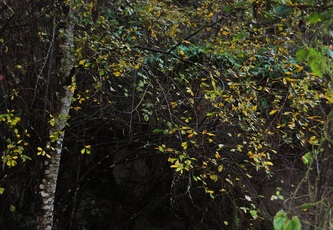
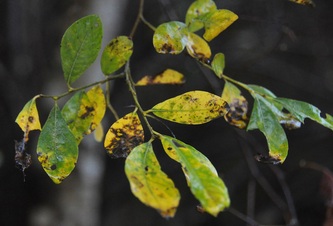
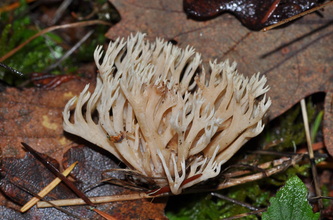
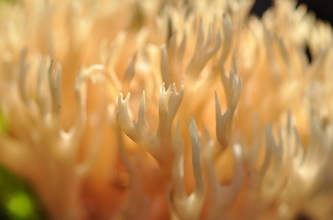
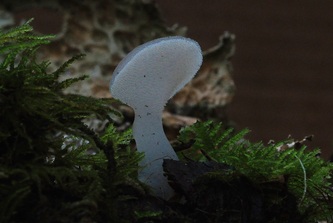
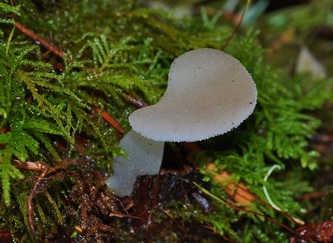
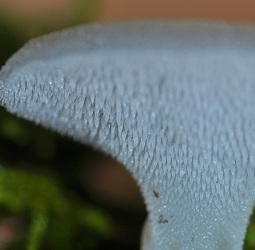
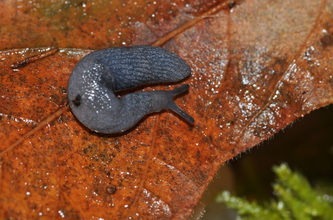
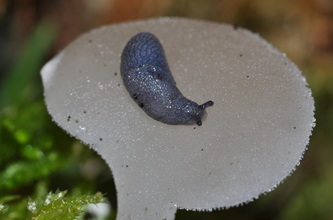
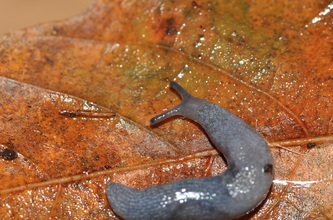
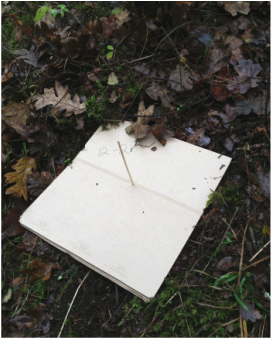
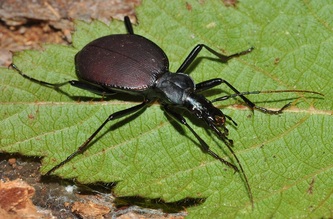
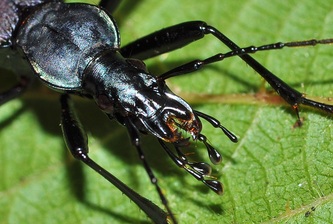
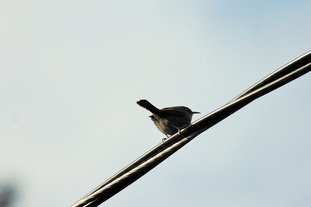
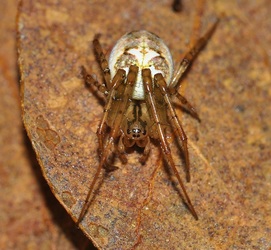
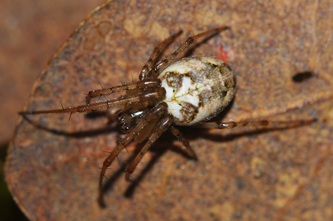
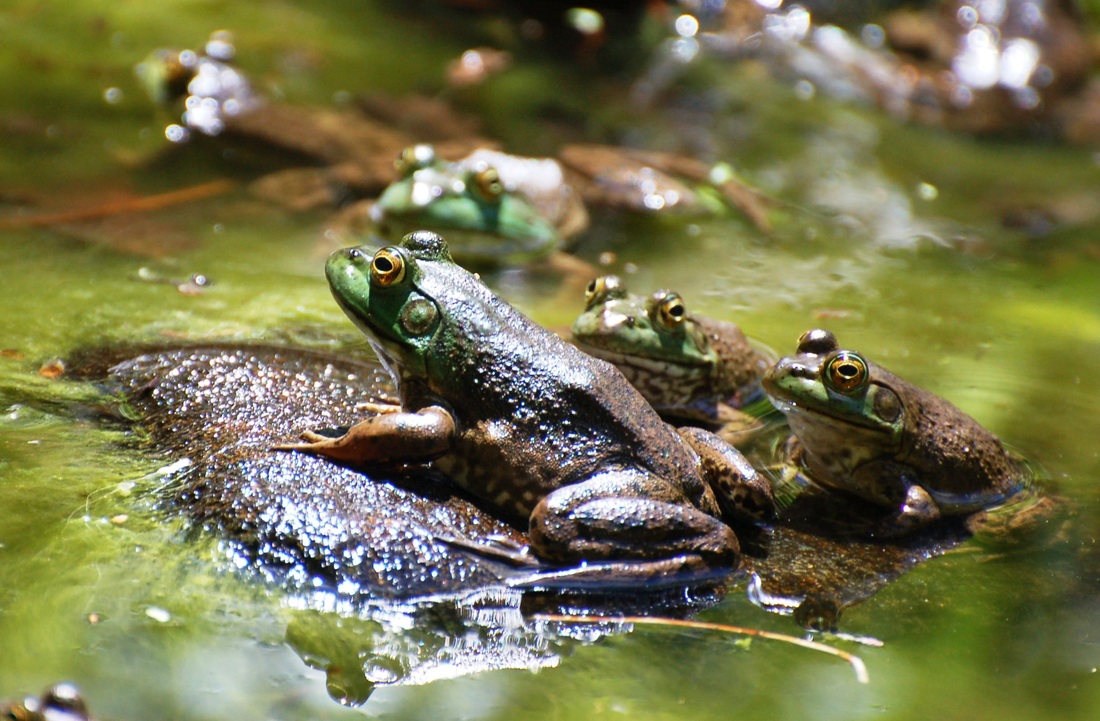
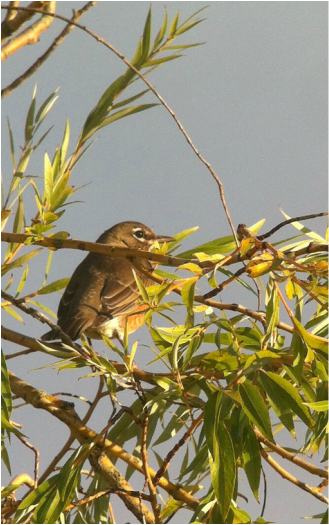
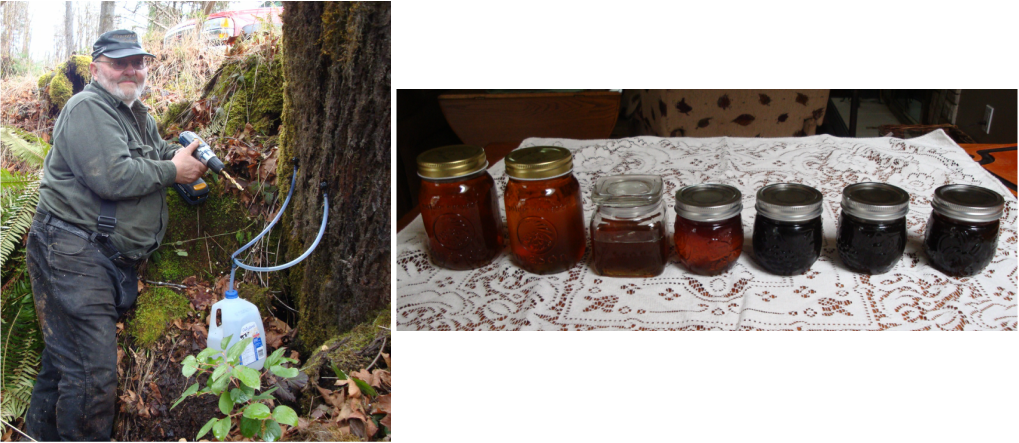
 RSS Feed
RSS Feed